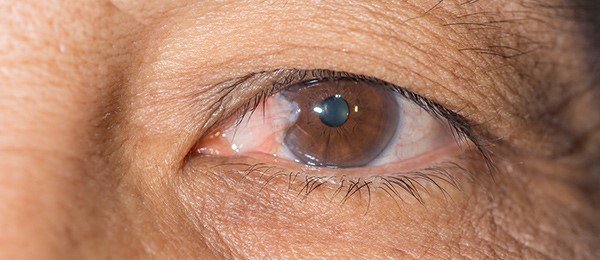A pterygium is a pinkish, triangular tissue growth on the cornea of the eye .It commonly starts on the cornea near the nose.
What is Pterygium?
A pterygium is a pinkish, triangular tissue growth on the cornea of the eye .It commonly starts on the cornea near the nose.

Signs and Symptoms
The diagnosis of pterygium is based on the clinical appearance of the lesion. Typical findings include:
- Triangular shape with the apex,neck & head, extending onto the cornea.
- It may affect the nasal and temporal limbus of both eyes or only a single location.
- Raised lesion, white to pink in color depending on vascularity.
- A pigmented epithelial iron line (Stocker’s line) adjacent to a pterygium is evidence of chronicity.
Treatment
Pterygium typically do not require surgery unless it grows to such an extent that it causes irritation, discomfort and visual problems.
Some of the symptoms such as irritation can be addressed with artificial tears. Surgery may be considered for unmanageable symptoms.
Pterygium Removal Surgery
PTERYGIUM EXCISION - As this method has a high recurrence it is not performed routinely now a days.
PTERYGIUM EXCISION WITH CONJUCTIVAL AUTOGRAFTING
Conjunctival auto-grafting is a surgical technique that is an effective and safe procedure for pterygium removal.[ When the pterygium is removed, the tissue that covers the sclera known as the Tenons layer is also removed. Auto-grafting covers the bare sclera with conjunctival tissue that is surgically removed from an area of healthy conjunctiva. That “self-tissue” is then transplanted to the bare sclera and is fixated using sutures or tissue adhesive.
PTERYGIUM EXCISION WITH MITOMYCIN –C
It can be utilized for primary pterygium but routinely it is utilized for recurrent pterygium surgery to reduce the rate of recurrence.
FAQ
When can travel be undertaken?
A pterygium should be removed if it is large and near the central cornea, if it is continually causing irritation or if it is cosmetically unacceptable.
What is involved in removing a pterygium?
A pterygium is surgically removed and an autoconjunctival graft is used to cover the area and reduce the risk of recurrence
Can my pterygium come back ?
Recurrence rates are much less in pterygium excision with conjuctival autografting
How long does the surgery take?
It will take approximately half hour.
Should I avoid surgery on my pterygium during the summer months?
There is no evidence to suggest that a pterygium removal should be restricted to a particular season.
Is surgery painful ?
The surgery itself is not painful but there is pain the following day which can be controlled with medication.
Is the surgery risky ?
No, the surgery is quite safe
Do I need to take time of work ?
Only on the day of surgery and perhaps the day after.
Are there any restrictions after pterygium surgery?
Only to avoid rubbing the eye